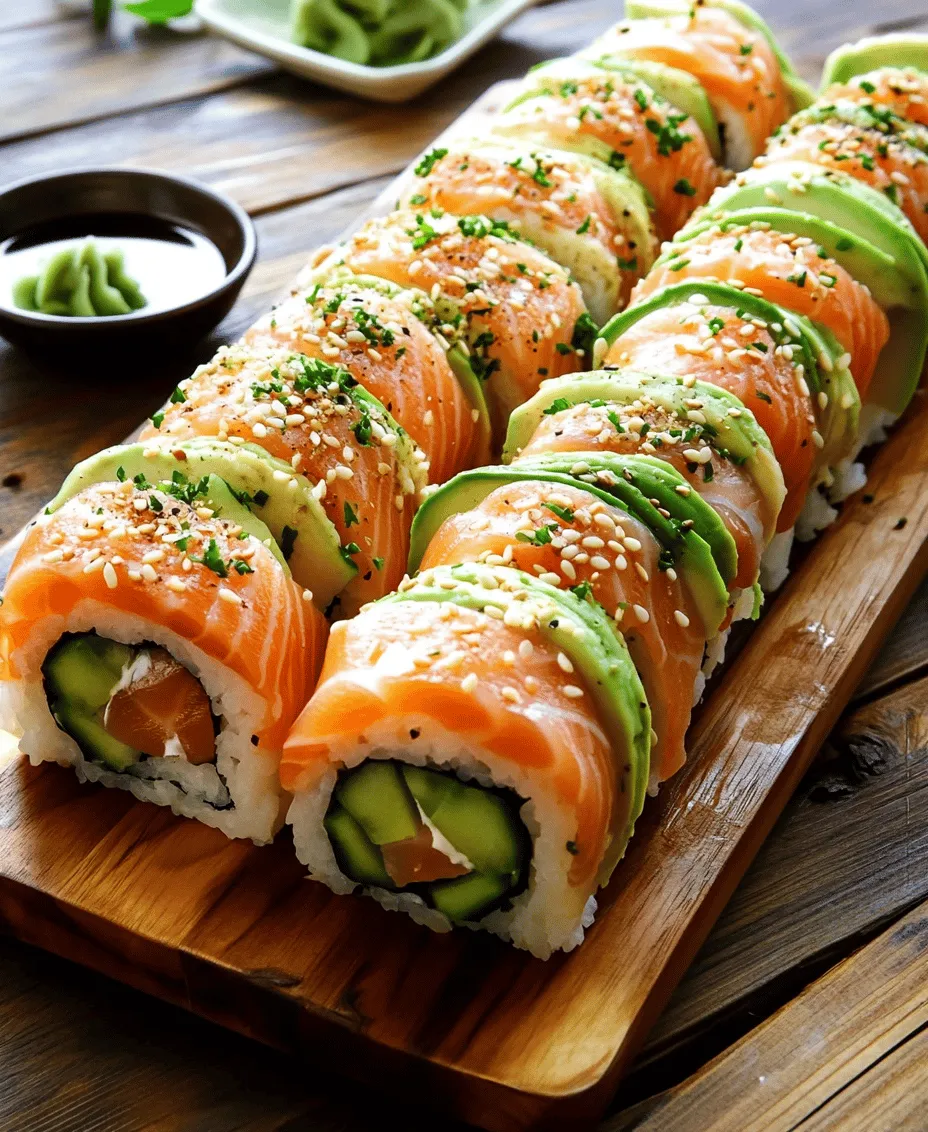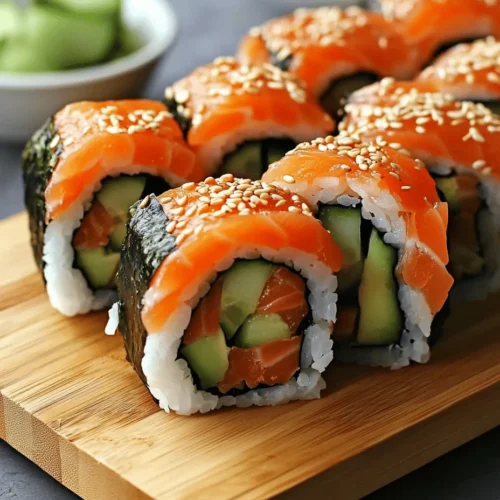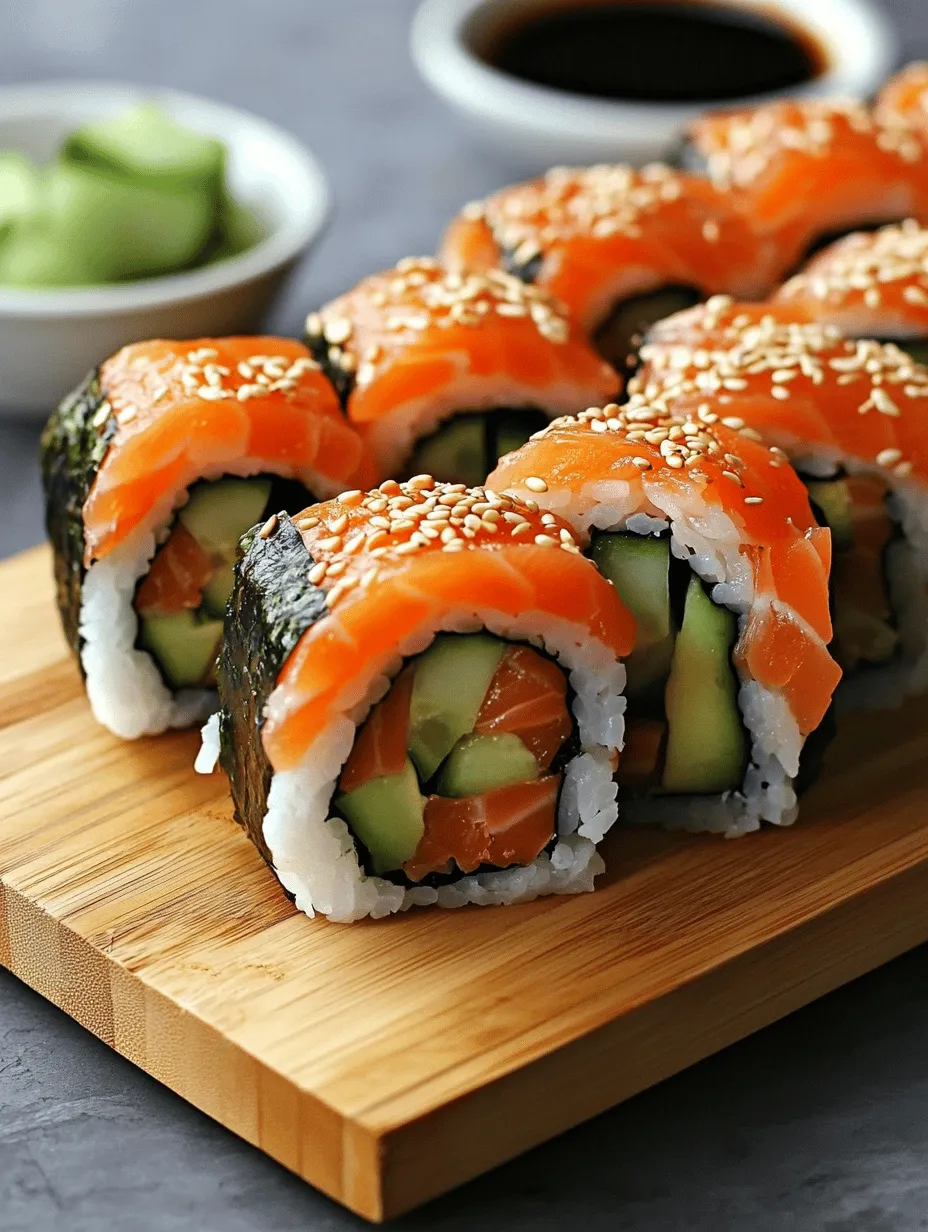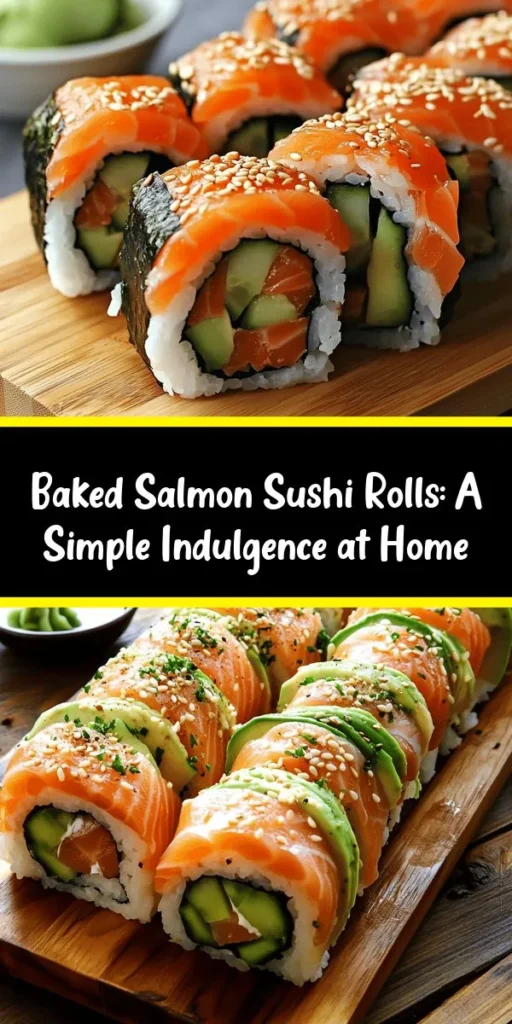Explore the delightful world of sushi with this Baked Salmon Sushi Rolls recipe, a perfect fusion of traditional flavors and modern cooking techniques. Sushi has evolved from its humble beginnings in Japan to become a beloved dish enjoyed around the globe. With its vibrant flavors and aesthetic appeal, sushi not only satisfies your cravings but also offers a healthy and nutritious meal option. In this article, we will break down the process of making these delicious sushi rolls, from preparing the sushi rice to assembling and serving, ensuring you have all the information needed for a successful culinary experience.
Understanding Sushi: A Brief Overview
Sushi, at its core, is a Japanese dish that typically consists of vinegared rice accompanied by various ingredients such as seafood, vegetables, and sometimes tropical fruits. The term “sushi” actually refers to the rice rather than the fish, and it comes from the word “su,” which means vinegar. The history of sushi can be traced back to the 8th century when it was originally a method of preserving fish in fermented rice. Over the centuries, sushi has transformed into the diverse culinary art form we recognize today.
There are several types of sushi, each with its own unique characteristics and cultural significance. Some of the most common types include:
– Nigiri: Hand-formed rice topped with a slice of fish or seafood.
– Sashimi: Thinly sliced raw fish, served without rice.
– Maki: Rolled sushi, typically wrapped in nori (seaweed) and filled with various ingredients.
– Uramaki: Inside-out rolls where the rice is on the outside and nori is on the inside.
– Temaki: Hand-rolled cones of nori filled with rice and various fillings.
The rise of sushi in global cuisine can be attributed to its explosion in popularity in the late 20th century. Today, sushi bars can be found in cities worldwide, and the dish has been adapted to suit local tastes, resulting in a myriad of variations. Baked sushi rolls, like our Baked Salmon Sushi Rolls, have become increasingly popular as they offer a unique twist on traditional sushi, combining the freshness of sushi with the comforting flavors of baked dishes.
The Appeal of Baked Salmon Sushi Rolls
Baked Salmon Sushi Rolls are not only delicious but also offer a host of health benefits. Salmon is rich in omega-3 fatty acids, which are essential for heart health, brain function, and reducing inflammation. Additionally, salmon is an excellent source of high-quality protein and is packed with vitamins and minerals including vitamin B12, selenium, and potassium. The health benefits of incorporating salmon into your diet are numerous, making it a popular choice among health-conscious individuals.
Baking salmon enhances its flavor and texture, resulting in a succulent filling for your sushi rolls. The gentle heat of the oven allows the salmon to cook evenly, creating a tender, flaky texture that pairs perfectly with the sushi rice. Moreover, baking reduces the need for oil or heavy sauces, allowing the natural flavors of the salmon to shine through.
Another advantage of baked sushi rolls is their convenience for home cooks. Unlike traditional sushi, which often requires precise techniques for rolling and handling raw fish, baked sushi rolls are more forgiving and approachable. This recipe allows you to enjoy the experience of making sushi at home without the pressure of achieving perfection with raw ingredients.
Ingredients Breakdown for Baked Salmon Sushi Rolls
To create the perfect Baked Salmon Sushi Rolls, it’s essential to gather the right ingredients. Here’s a breakdown of what you will need:
Sushi Rice
Sushi rice is the foundation of any sushi roll, and its quality can significantly impact the final dish. When selecting sushi rice, look for short-grain or medium-grain varieties, as they are stickier and will hold together better when rolled. It’s important to rinse the rice thoroughly before cooking to remove excess starch, which can make the rice gummy. Rinsing helps achieve the perfect texture—fluffy and sticky without being overly clumpy.
Salmon
Choosing the right salmon is crucial for making delicious sushi. Fresh salmon is ideal, but frozen options can also be suitable if handled properly. When selecting salmon for sushi, look for sushi-grade fish from reputable sources to ensure safety and quality. Sushi-grade salmon is typically flash-frozen to kill potential parasites, making it safe for raw consumption. If you prefer a fully cooked option, baking it will also yield a flavorful result.
Nori
Nori is the seaweed that wraps the sushi rolls. It adds flavor and texture, playing an essential role in the overall experience of sushi. When selecting nori, look for sheets that are dark green and have a shiny appearance, as these are usually of better quality. Nori can be found at most grocery stores or Asian markets, and it adds a delightful umami flavor to your baked rolls.
Avocado and Cucumber
Avocado and cucumber are classic ingredients in sushi rolls that provide freshness and balance. Avocado adds a creamy texture and healthy fats, while cucumber contributes a satisfying crunch. Together, they enhance the overall flavor profile of the sushi rolls, making them more enjoyable.
Seasonings
Seasonings play a vital role in elevating the flavors of your sushi. Rice vinegar, sugar, and salt are typically combined to season the sushi rice, giving it a tangy and slightly sweet flavor that complements the other ingredients. This combination is crucial for achieving the authentic taste of sushi rice.
Step-by-Step Guide to Preparing Baked Salmon Sushi Rolls
Now that we have a clear understanding of the ingredients and their significance, let’s dive into the step-by-step guide for preparing Baked Salmon Sushi Rolls. We’ll start with the first and most important component: preparing the sushi rice.
Preparing the Sushi Rice
1. Rinsing the Rice
Begin by measuring out your sushi rice—typically, 2 cups will yield about 4 servings. Place the rice in a fine-mesh strainer and rinse it under cold water. Use your hands to gently agitate the rice, allowing the water to run clear. This process is crucial as it removes excess starch, preventing the rice from becoming overly sticky.
2. Cooking Methods: Rice Cooker vs. Stovetop
– Rice Cooker: If you have a rice cooker, add the rinsed rice and 2 1/4 cups of water, then turn it on and let it cook according to the manufacturer’s instructions. Rice cookers are designed to yield perfectly cooked rice with minimal effort.
– Stovetop: If you prefer cooking on the stovetop, combine the rinsed rice and water in a saucepan, bringing it to a boil over medium-high heat. Once boiling, reduce the heat to low, cover, and simmer for about 18-20 minutes. Avoid lifting the lid during cooking to ensure even steaming.
3. Cooling and Seasoning the Rice
Once the rice is cooked, transfer it to a large bowl to cool. To season the rice, mix together 1/3 cup of rice vinegar, 2 tablespoons of sugar, and 1 teaspoon of salt in a small bowl until dissolved. Gently fold the seasoning mixture into the warm rice using a wooden spatula, being careful not to mash the grains. Allow the rice to cool to room temperature before proceeding to assemble your sushi rolls.
By following these foundational steps, you will ensure that your sushi rice is perfectly prepared, setting the stage for delicious Baked Salmon Sushi Rolls. In the next section, we will explore the assembly process, diving deeper into how to create these delightful rolls that will impress both family and friends. Stay tuned for the next part of this culinary journey!

Baking the Salmon
To create the perfect Baked Salmon Sushi Rolls, the first step is to bake the salmon. This method not only enhances the flavor but also ensures that the fish is perfectly cooked and flakes beautifully.
Preheating and Preparing Your Oven
Begin by preheating your oven to 375°F (190°C). This temperature is ideal for baking salmon, as it allows the fish to cook through without drying out. While the oven is heating, prepare a baking sheet by lining it with parchment paper or aluminum foil. This will make cleanup easy and prevent the salmon from sticking to the pan. Once the oven is ready, place the salmon fillets skin-side down on the prepared baking sheet.
Flavoring the Salmon with Olive Oil, Soy Sauce, and Lemon Juice
To infuse flavor into the salmon, drizzle a tablespoon of olive oil over the fillets. This not only adds richness but also helps in achieving a moist texture. Next, use about two tablespoons of soy sauce to give the salmon a savory umami flavor. Finally, squeeze half a lemon over the fillets for a bright, zesty contrast. You can also sprinkle some freshly cracked black pepper or sesame seeds on top for added flavor and crunch.
Tips for Achieving Perfectly Flaky Salmon
To ensure your salmon turns out flaky and tender, avoid overcooking it. As a general rule, bake the salmon for 12-15 minutes, depending on the thickness of the fillets. A good indicator that the salmon is done is when it flakes easily with a fork and has an internal temperature of 145°F (63°C). For an extra touch, you can broil the salmon for the last 2-3 minutes of cooking to achieve a nice, slightly crispy top. Once done, let the salmon cool slightly before flaking it into pieces for your sushi rolls.
—
Assembling the Sushi Rolls
With the salmon prepared, it’s time to assemble your sushi rolls. This is where the fun begins, and having a well-organized workspace will make the process easier.
Setting Up Your Workspace with a Bamboo Sushi Mat
Start by laying out your bamboo sushi mat on a clean, flat surface. Having a dedicated space will help you maintain order as you prepare your rolls. It’s also helpful to have a small bowl of water nearby, which you can use to wet your hands while handling the sushi rice. This prevents the rice from sticking to your fingers, making it easier to work with.
Techniques for Spreading Rice and Filling the Sushi
Once your sushi mat is ready, take a sheet of nori (seaweed) and place it shiny side down on the mat. Wet your hands and grab a handful of sushi rice, about one cup, and spread it evenly over the nori, leaving about an inch of space at the top edge. Use gentle pressure to ensure the rice sticks to the nori without squishing it.
Next, add your filling. For baked salmon rolls, spread a line of flaked salmon horizontally across the center of the rice. You can also add cucumber sticks, avocado slices, or any other preferred fillings to enhance the flavor and texture of your rolls.
Proper Rolling Methods to Ensure a Tight Roll
To roll the sushi, lift the edge of the bamboo mat closest to you and start rolling it over the filling, using your fingers to keep the filling in place. As you roll, apply gentle pressure to create a tight roll. Once you reach the exposed edge of the nori, wet it slightly to help it seal. Continue rolling until you have a complete sushi roll. You can use a sharp knife to slice the roll into bite-sized pieces, but be careful not to squish the roll while cutting.
—
Slicing and Serving
The final step in preparing your Baked Salmon Sushi Rolls is slicing and serving them in a visually appealing way.
Tools Needed for Slicing Sushi Rolls
To achieve clean slices, use a very sharp knife. It’s best to wet the blade with water to prevent sticking, which can cause the rice to tear. Using a serrated knife can also help in achieving clean cuts, especially for rolls with a lot of fillings.
Presentation Tips for Showcasing Your Sushi
For an impressive presentation, arrange the sushi rolls on a clean serving platter. You can garnish the plate with pickled ginger, wasabi, and a small dish of soy sauce for dipping. Consider adding some sliced green onions or sesame seeds on top of the sushi for an extra touch of color and flavor.
Pairing Suggestions with Pickled Ginger and Soy Sauce
Baked Salmon Sushi Rolls pair wonderfully with pickled ginger, which serves as a palate cleanser between bites. Soy sauce is a classic accompaniment, adding a savory depth to each roll. For those who enjoy a bit of heat, try adding a touch of wasabi to your soy sauce for an extra kick.
—
Nutritional Benefits of Baked Salmon Sushi Rolls
Baked Salmon Sushi Rolls are not only delicious but also pack a nutritional punch, making them a smart choice for a wholesome meal.
Overview of the Health Benefits of Key Ingredients
Salmon is renowned for its health benefits, being rich in omega-3 fatty acids, which are essential for heart health and brain function. It is also a great source of protein, which helps in muscle repair and growth. Sushi rice, while higher in carbohydrates, provides energy, and the inclusion of vegetables like cucumber and avocado adds fiber, vitamins, and minerals.
Nutritional Breakdown per Serving
A typical serving of Baked Salmon Sushi Rolls (approximately 8 pieces) contains:
– Calories: 350
– Protein: 20g
– Carbohydrates: 50g
– Fat: 10g
– Fiber: 5g
This balance of macronutrients makes it a fulfilling meal option.
How This Dish Fits into a Balanced Diet
Incorporating Baked Salmon Sushi Rolls into your diet can complement various dietary needs. The omega-3 fatty acids from salmon contribute to a balanced diet, while the fiber from vegetables supports digestive health. Additionally, this dish can easily be modified to fit different dietary preferences, such as using brown rice for a whole grain option or adding more vegetables for a vegetarian twist.
—
Cultural Significance of Sushi in Modern Cuisine
Sushi has evolved from its traditional roots into a beloved cuisine worldwide, marking its significance in both social and culinary contexts.
Sushi as a Social Food: Sharing and Serving
Sushi is often enjoyed in social settings, as it brings people together. Whether at a sushi restaurant or at home, the act of sharing sushi rolls fosters a sense of community. Many people enjoy making sushi together, allowing for creativity and collaboration in the kitchen.
The Evolution of Sushi in Western Culture
Originally a Japanese delicacy, sushi has undergone many transformations as it has spread across the globe. In Western culture, sushi has been adapted to include local flavors and ingredients, resulting in a variety of styles, such as California rolls and sushi burritos. This evolution has made sushi accessible and appealing to a broader audience.
Sushi Trends: From Traditional to Contemporary Adaptations
Modern sushi trends continue to innovate, with chefs experimenting with flavors, presentation, and even plant-based options. Sushi bowls, sushi burgers, and even dessert sushi are gaining popularity, showcasing the versatility of this beloved dish.
—
Conclusion
Baked Salmon Sushi Rolls offer a delicious and approachable way to enjoy sushi at home. With a few simple ingredients and straightforward steps, you can create a meal that is not only enjoyable to eat but also a treat to share with family and friends. This recipe combines the best of both worlds: traditional flavors and modern cooking methods, making it a perfect choice for both sushi lovers and home cooks looking to expand their culinary repertoire. Whether you’re hosting a special occasion or simply craving something unique, these sushi rolls are sure to impress. Enjoy the delightful flavors, embrace the cultural significance of sushi, and relish the nutritional benefits of this remarkable dish.



